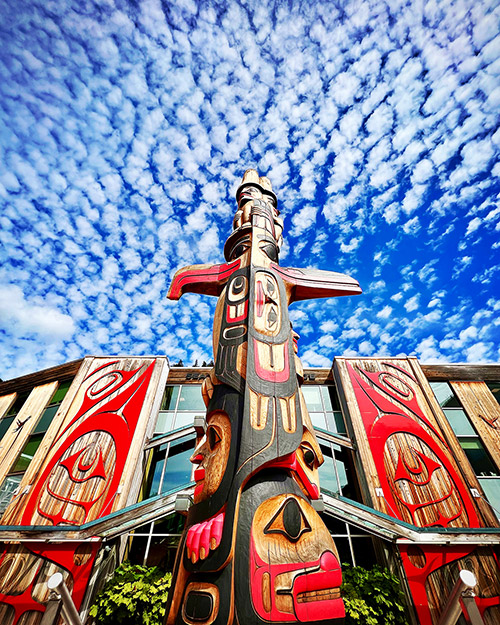
U.S. CONGRESSWOMAN FILES RESOLUTION DESIGNATING NORTHWEST COAST ART A NATIONAL TREASURE
Move part of institute’s vision to make Juneau the Northwest Coast arts capital
July 31, 2024
U.S. Representative Mary Peltola of Alaska has filed a resolution to designate Northwest Coast art as a rare and valuable national treasure.
The resolution, filed earlier this year, states that Northwest Coast art has achieved preeminence throughout the world as an Indigenous American art form that has had a historic, pervasive and continuing influence on other genres of art in the United States.
The resolution asserts that the ancient art practice is a unifying force, bridging cultural, religious, ethnic and age differences in our diverse society.
SHI President Rosita Worl, Ph.D., called it an important first step toward recognizing the art form at the federal level.
“We have been promoting the adoption of Northwest Coast art as a national treasure in the same way that jazz was designated a national treasure by Congress in 1987,” Worl said. “Northwest Coast art is an ancient, distinctive art form dating back thousands of years, and it is unique in the world.”
If passed, Congress would recognize Northwest Coast art as “a rare and valuable national treasure to which we should devote support and any necessary resources to make certain that it is preserved, understood, and able to be passed down.” It would also assert that the art form “remains a major cultural force in many Indigenous communities and contributes to the rich heritage and cultural diversity of this Nation and should be protected under the laws of the United States.”
The resolution, H. Con. Res. 107, was introduced in the U.S. House of Representatives on May 6, 2024, and referred to the House Committee on Oversight and Accountability.
About Northwest Coast Art
Northwest Coast art evolved over several thousand years in the rich and complex Indigenous societies of the Pacific Northwest of North America. Art adorned everything from monumental structures and ceremonial regalia to basic utilitarian objects. The simplicity of the design components—elements of a system known as formline design—belie the complexity and sophistication that was achieved in this two-dimensional Northwest Coast (NWC) art tradition. From the earliest contact with Westerners, wood carvings, weavings and other cultural pieces depicting NWC art were aggressively collected by museums and visitors and acclaimed as one of the most distinctive and unique art traditions in the world. Today, this ancient tradition continues to evolve through the work of contemporary NWC artists. The Northwest Coast is home to more than 18 distinct tribes stretching from northern California to the Alaskan panhandle, the land of the Tlingit, Haida and Tsimshian people of Southeast Alaska.
Sealaska Heritage Institute is a private nonprofit founded in 1980 to perpetuate and enhance Tlingit, Haida and Tsimshian cultures of Southeast Alaska. Its goal is to promote cultural diversity and cross-cultural understanding through public services and events. SHI also conducts scientific and public policy research that promotes Alaska Native arts, cultures, history and education statewide. The institute is governed by a Board of Trustees and guided by a Council of Traditional Scholars, a Native Artist Committee and a Southeast Regional Language Committee.
CONTACT: Kathy Dye, SHI Communications and Publications Deputy Director, 907.321.4636, kathy.dye@sealaska.com.
Captions: Sealaska Cultural Values Totem Pole carved by Haida master artist TJ Young with assistance from Tlingit and Tsimshian carvers in Juneau. The pole stands in front of SHI’s Walter Soboleff Building, which features art by Haida master artist Robert Davidson. Photo by Mircea Brown, courtesy of Sealaska Heritage Institute. Gold, carved Thunderbird cuff by Tlingit master artist Amos Wallace. Photo by Brian Wallace, courtesy of Sealaska Heritage Institute. Note: Media outlets are welcome to use this photo for coverage of this story. For a higher resolution image or for additional photos showing examples of Northwest Coast Native art, contact kathy.dye@sealaska.com